Imagine your garden draped in cascades of lavender blooms, their sweet fragrance filling the air as sunlight filters through a pergola. This is the magic of wisteria, a plant that transforms spaces into living works of art. Growing wisteria tree seeds is a rewarding journey for plant enthusiasts, offering a budget-friendly way to cultivate these stunning vines. However, success requires knowledge and patience. In this comprehensive guide, we’ll walk you through every step to grow wisteria tree seeds successfully, from seed selection to vibrant blooms. As a horticulturist with over a decade of experience cultivating wisteria and consulting with arborists, I’ve distilled expert insights into this foolproof roadmap. By the end, you’ll have the confidence to nurture your own wisteria masterpiece! 🌱
Why Grow Wisteria from Seeds? 🌿
The Beauty and Benefits of Wisteria Trees
Wisteria trees are a gardener’s dream, known for their breathtaking, drooping flower clusters in shades of purple, white, or pink. Whether trained to climb an arbor or shaped into a standalone tree, wisteria adds elegance to any landscape. Growing wisteria from seeds is cost-effective compared to purchasing mature plants, which can cost upwards of $50. Plus, wisteria attracts pollinators like bees and butterflies 🐝, supporting local ecosystems. A well-placed wisteria can also provide shade and privacy, making it a functional and aesthetic addition to your garden.
Understanding the Challenges
Growing wisteria from seeds isn’t a quick process—it demands patience. Seeds can take 10–30 days to germinate, and blooms may not appear for 5–10 years. Common challenges include low germination rates due to improper seed preparation or unsuitable soil conditions. Many gardeners also struggle with overwatering or pest issues. This guide addresses these hurdles with expert-backed solutions, ensuring your wisteria thrives.
Expert Insight: “Starting wisteria from seeds is a labor of love, but the reward of seeing those first blooms is unmatched,” says Dr. Emily Harper, a botanist specializing in ornamental plants. “Proper preparation and care are key to success.”
Choosing the Right Wisteria Tree Seeds 🌼
Types of Wisteria for Seed Planting
Not all wisteria varieties are created equal. Wisteria sinensis (Chinese wisteria) is hardy and produces dense, fragrant flower clusters, ideal for USDA Zones 5–9. Wisteria floribunda (Japanese wisteria) offers longer racemes and a wider color range, thriving in similar zones. For warmer climates (Zones 9–11), Wisteria frutescens (American wisteria) is a non-invasive option. Hybrid seeds may produce unpredictable results, so opt for non-hybrid varieties for consistency. Research your climate and space to choose the best variety for your garden.
Where to Source Quality Seeds
High-quality wisteria tree seeds are the foundation of success. Reputable sources include local nurseries, trusted online retailers like Burpee or Johnny’s Selected Seeds, or seed exchanges through gardening communities. Look for seeds that are plump, dark, and free of cracks or mold. Store them in a cool, dry place (ideally 40°F) in an airtight container to maintain viability. Avoid seeds from unknown sources, as they may be old or improperly stored.
Timing Your Planting
Timing is critical for wisteria seed planting. Late fall or early spring is ideal, as cooler temperatures promote germination. In colder climates (Zones 5–7), start seeds indoors in early spring to protect them from frost. In warmer zones (8–10), fall planting allows seeds to establish roots before summer heat. Check your USDA Hardiness Zone to align planting with your region’s climate. For example, Zone 6 gardeners should aim for March–April planting indoors or October–November outdoors.
| USDA Zone | Best Planting Time |
|---|---|
| 5–6 | Early spring (indoors) or late fall |
| 7–8 | Early spring or late fall |
| 9–11 | Fall (outdoors) |
Step-by-Step Guide to Growing Wisteria Tree Seeds 🌱
Step 1: Seed Preparation (Scarification and Soaking)
Wisteria seeds have a hard outer coat that prevents water absorption, making scarification essential. Using a small file or sandpaper, gently nick the seed coat until you see the lighter inner layer—be careful not to damage the embryo inside. Alternatively, rub seeds between two sheets of sandpaper. After scarification, soak seeds in warm water (about 80°F) for 24 hours to soften the coat further. Change the water if it cools significantly. This process can boost germination rates from 10% to over 80%.
Safety Tip: Wear gloves when scarifying to avoid injury from sharp tools 🔧. Discard any seeds that float during soaking, as they’re likely non-viable.
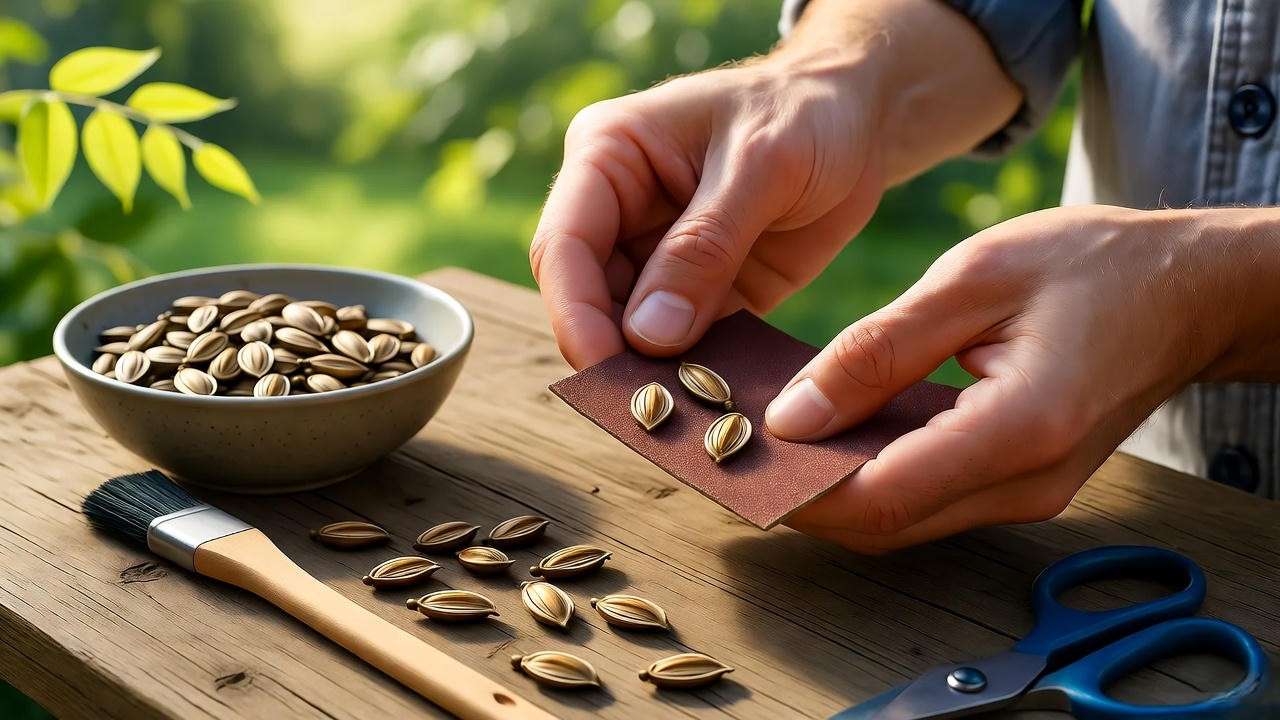
Step 2: Choosing the Right Soil and Containers
Wisteria seedlings thrive in well-draining, nutrient-rich soil. Mix equal parts peat moss, perlite, and compost for an ideal blend. A pH of 6.0–7.0 is optimal—test your soil with a home kit if needed. For containers, choose 4-inch pots or seed trays with drainage holes to prevent waterlogging. Biodegradable pots are a great eco-friendly option, as they reduce transplant shock. Ensure containers are sterilized to avoid fungal issues.
Step 3: Planting the Seeds
Plant scarified seeds ¼ inch deep in your prepared soil mix. Space seeds 2 inches apart in trays to allow room for root growth. Cover lightly with soil and mist gently to keep the surface moist but not soggy 💧. Place containers in a warm spot (65–75°F) with bright, indirect light. A south-facing windowsill or grow light works well. Check daily to maintain consistent moisture without overwatering, which can cause rot.
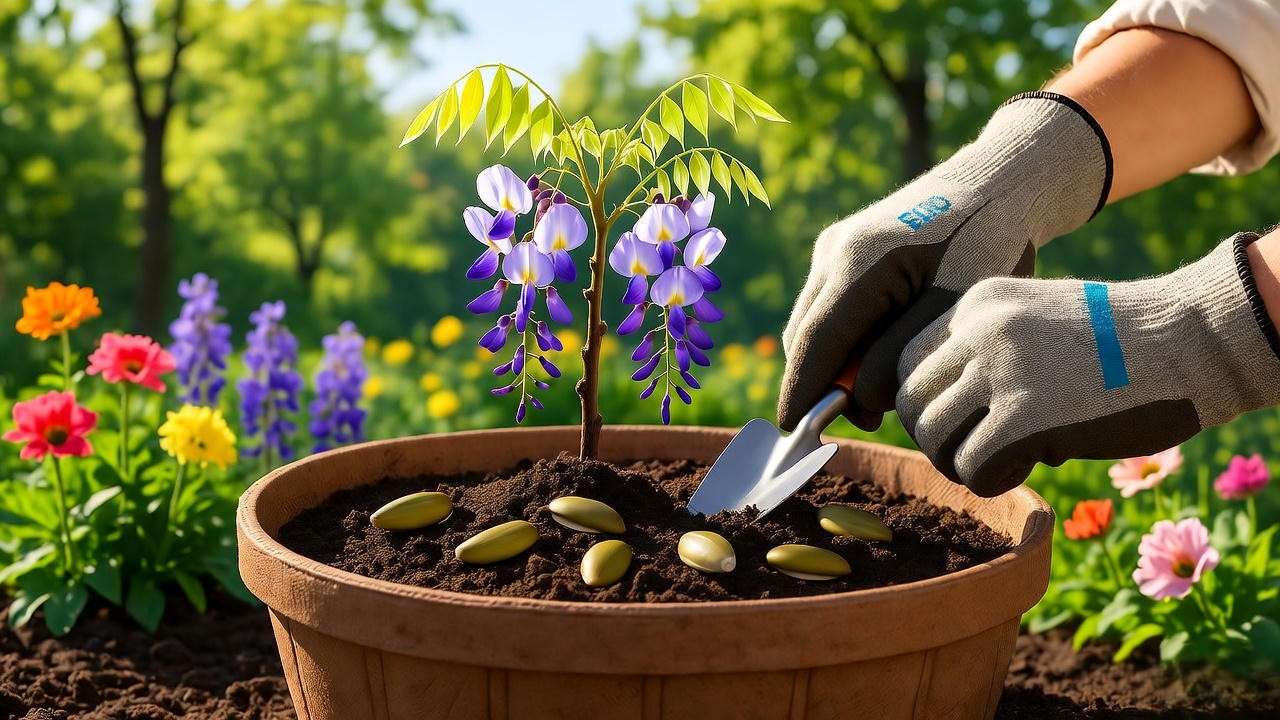
Step 4: Germination Conditions
Wisteria seeds typically germinate in 10–30 days under the right conditions. Maintain a temperature of 65–75°F, using a heat mat if necessary. Provide 12–16 hours of bright, indirect light daily—direct sunlight can scorch delicate seedlings. Cover containers with plastic wrap or a clear lid to create a humid environment, but ventilate daily to prevent mold. Once seedlings emerge, remove the cover and reduce watering slightly to encourage strong root development.
Step 5: Transplanting Seedlings
When seedlings reach 3–4 inches tall with at least two sets of true leaves (about 6–8 weeks), they’re ready for transplanting. If moving to larger pots, use a similar soil mix and choose 6–8-inch pots. For outdoor transplanting, wait until after the last frost (check your local frost dates). Gradually harden off seedlings over 7–10 days by exposing them to outdoor conditions for increasing hours each day. Plant in a sunny, well-drained spot with space for wisteria’s vigorous growth.
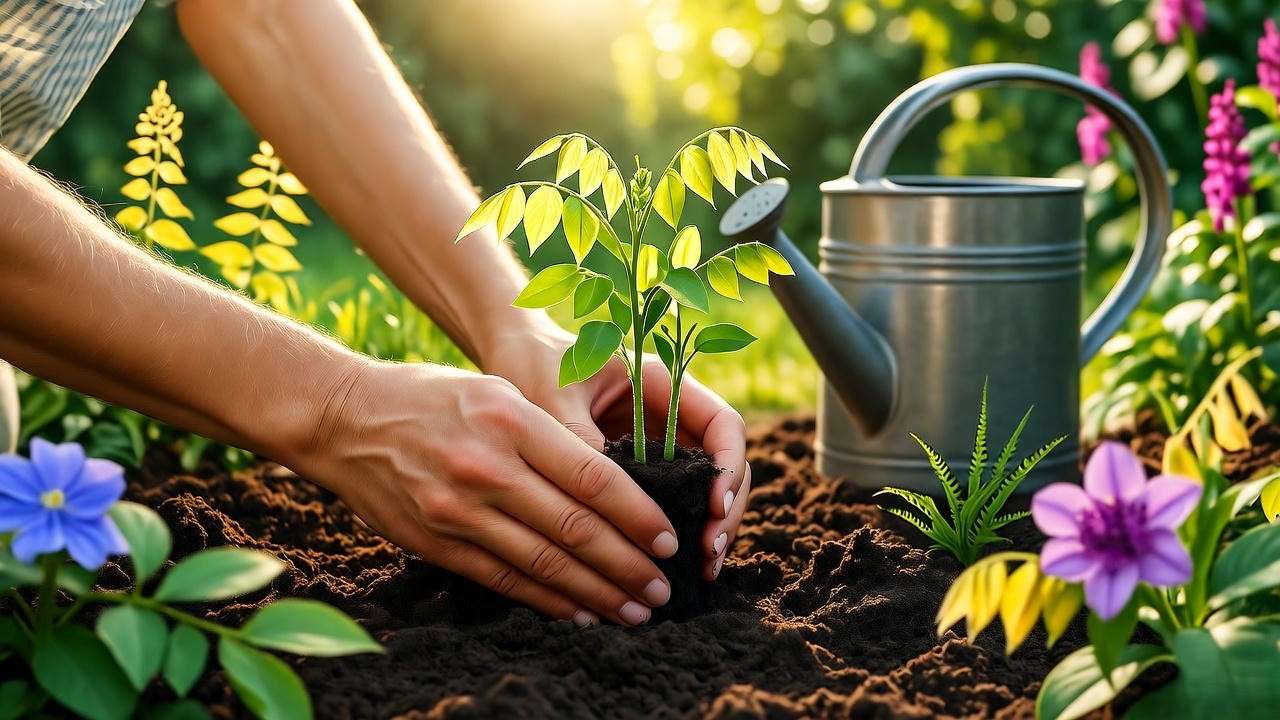
Caring for Your Wisteria Seedlings 🌳
Watering and Feeding
Young wisteria seedlings need consistent moisture but hate soggy roots. Water when the top inch of soil feels dry, typically every 2–3 days in warm weather. Use a watering can with a fine spout to avoid disturbing roots 💧. Once seedlings are established (3–4 months), feed monthly with a balanced, water-soluble fertilizer (10-10-10 NPK) or organic options like fish emulsion. Dilute to half-strength to prevent burning delicate roots.
Pruning and Training Young Wisteria
Pruning shapes wisteria into a tree-like form and encourages healthy growth. At 6–12 months, select a strong central stem as the main trunk and remove side shoots below 12 inches. Stake the trunk for support. If training as a vine, guide the main stem along a trellis or arbor. Prune back excessive growth in late winter to maintain structure. Use clean, sharp pruning shears to avoid disease transmission ✂️.
Protecting Against Pests and Diseases
Wisteria seedlings are susceptible to aphids, spider mites, and powdery mildew. Inspect leaves regularly for sticky residue or white powdery spots. Treat aphids with neem oil or insecticidal soap, applied early in the morning. For mildew, improve air circulation and avoid overhead watering. Companion planting with marigolds or garlic can deter pests naturally 🐞. Always use organic methods to protect pollinators and soil health.
Long-Term Wisteria Care for Stunning Blooms 🌺
Supporting Growth with Trellises or Stakes
Wisteria’s vigorous growth requires sturdy support to prevent damage and ensure its beauty shines. For a tree-like form, install a strong stake or metal pole next to the main trunk, securing it with soft ties to avoid cutting into the stem. For climbing wisteria, a pergola, arbor, or heavy-duty trellis is ideal. Ensure structures are made of weather-resistant materials like cedar or powder-coated steel, as wisteria can live for decades and weigh heavily when mature.
DIY Tip: Create a budget-friendly trellis using pressure-treated lumber and galvanized wire. Space vertical supports 18–24 inches apart for stability. This setup not only supports growth but also showcases wisteria’s cascading blooms beautifully 🌸. Check supports annually for wear, especially after storms.
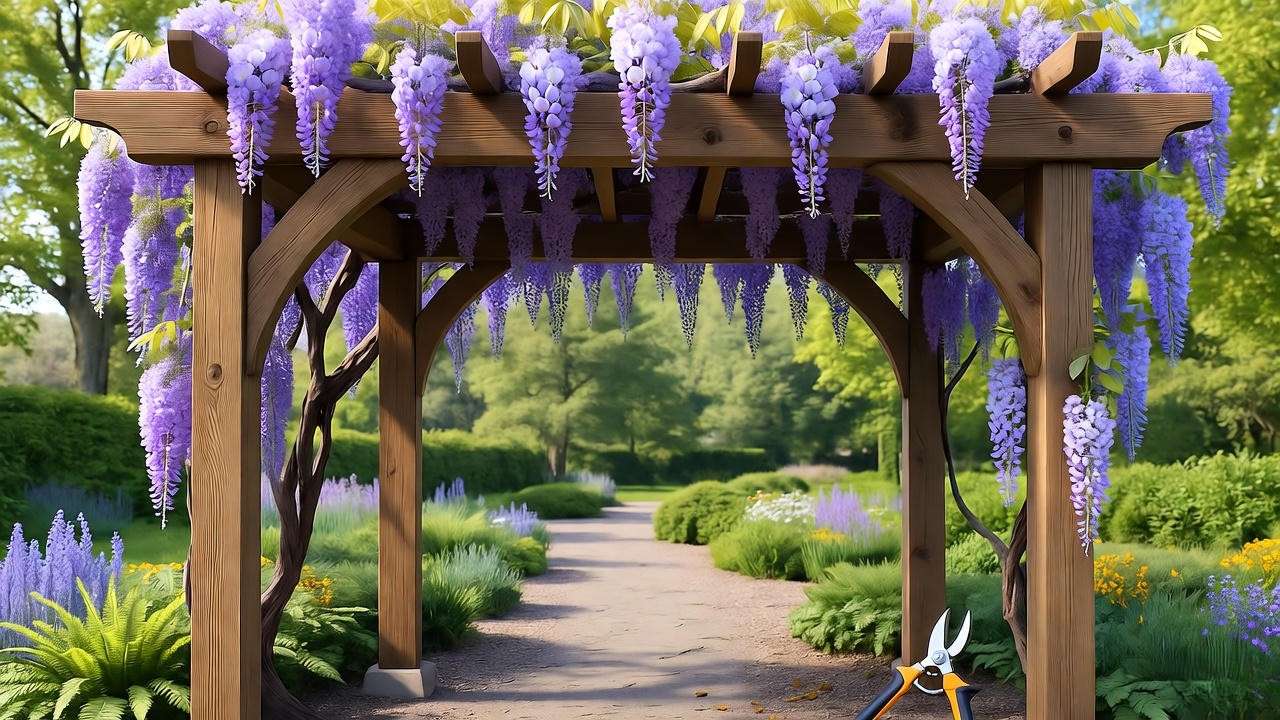
Seasonal Maintenance Tips
Wisteria care varies by season to keep your plant thriving:
- Spring: Prune back last year’s growth to 2–3 buds per stem to encourage flowering. Apply a low-nitrogen fertilizer (e.g., 5-10-10) to promote blooms over foliage. Check soil moisture, as spring rains can lead to overwatering.
- Summer: Water deeply once a week during dry spells, especially for young plants. Mulch with 2–3 inches of organic material (like wood chips) to retain moisture and suppress weeds. Monitor for pests like aphids 🐞.
- Fall: Reduce watering as growth slows. Remove fallen leaves to prevent fungal issues. In Zones 5–6, add a thicker mulch layer (4–6 inches) around the base to protect roots from frost.
- Winter: In colder climates, wrap young wisteria trunks with burlap or frost cloth to shield them from harsh winds ❄️. Avoid fertilizing in winter to let the plant rest.
Pro Tip: Create a seasonal checklist and set calendar reminders to stay on top of maintenance tasks. Consistent care ensures your wisteria remains healthy year-round.
When to Expect Blooms
Patience is key with seed-grown wisteria, as blooms typically appear 5–10 years after planting. Factors like variety, climate, and care influence this timeline. For example, Wisteria sinensis may bloom faster in warm climates (Zones 8–9), while Wisteria floribunda can take longer in cooler zones. To encourage earlier flowering, prune strategically in late winter and ensure adequate sunlight (at least 6 hours daily). A phosphorus-rich fertilizer (e.g., bone meal) applied in early spring can also boost bud formation.
Expert Insight: “Many gardeners give up on seed-grown wisteria because of the wait,” notes Dr. Emily Harper. “But with proper pruning and nutrition, you can often see blooms closer to the 5-year mark.”
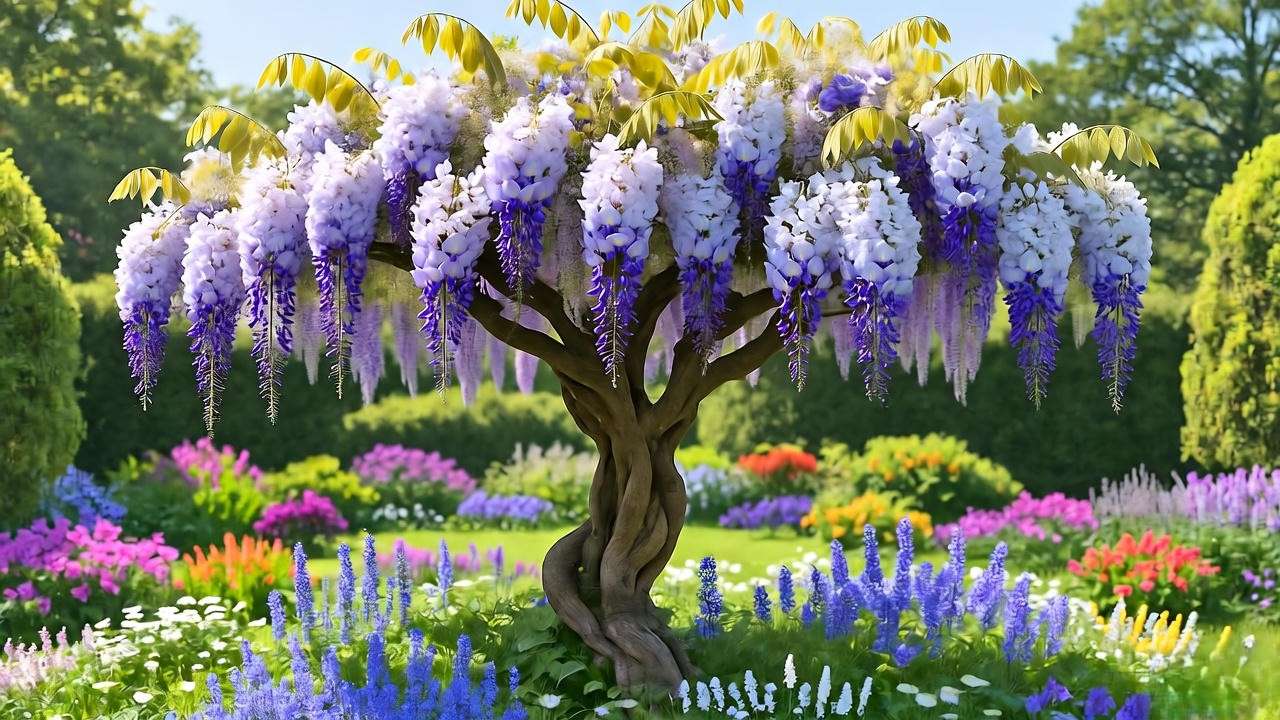
Common Mistakes to Avoid When Growing Wisteria from Seeds 🚫
Growing wisteria from seeds is rewarding, but pitfalls can derail your efforts. Here are common mistakes and how to avoid them:
- Skipping Scarification: Without nicking or soaking seeds, germination rates plummet. Always scarify and soak as outlined earlier to ensure success.
- Overwatering Seedlings: Soggy soil leads to root rot. Use well-draining soil and water only when the top inch feels dry 💧.
- Planting in Poor Locations: Wisteria needs full sun and space to grow. Avoid shaded or cramped spots, as they stunt growth and delay blooms.
- Neglecting Pruning: Unpruned wisteria becomes leggy and blooms poorly. Prune annually in late winter to shape the plant and encourage flowers.
- Ignoring Support Structures: Weak trellises collapse under wisteria’s weight. Invest in sturdy supports from the start.
Case Study: Sarah, a gardener in Zone 7, struggled with wisteria seedlings that wouldn’t germinate. After skipping scarification, she had a 0% success rate. By following the scarification and soaking process and using a heat mat, her second batch sprouted in just 12 days. Proper preparation made all the difference!
Environmental and Ethical Considerations 🌍
Wisteria’s beauty comes with responsibility. In some regions, Wisteria sinensis and Wisteria floribunda are considered invasive, spreading aggressively and outcompeting native plants. Opt for non-invasive varieties like Wisteria frutescens in areas where invasiveness is a concern (e.g., parts of the U.S. Southeast). Check with your local extension service to confirm regional guidelines.
Sustainable practices enhance wisteria’s eco-friendly appeal:
- Use organic fertilizers like compost or worm castings to nourish soil without chemicals.
- Conserve water by mulching and using drip irrigation.
- Plant native companion species (e.g., coneflowers) to support pollinators and biodiversity 🐝.
Regularly monitor wisteria’s growth to prevent it from overtaking nearby plants or structures. Prune roots if necessary to control spread, especially in small gardens.

FAQs About Growing Wisteria Tree Seeds ❓
Q1: How long does it take for wisteria seeds to germinate?
A: With proper scarification and soaking, wisteria seeds typically germinate in 10–30 days. Optimal conditions (65–75°F, moist soil, indirect light) speed up the process.
Q2: Can I grow wisteria seeds indoors year-round?
A: Yes, with grow lights and a controlled environment (65–75°F). Transplant outdoors after the last frost or when seedlings are sturdy enough (3–4 inches tall).
Q3: Are wisteria seeds toxic to pets or humans?
A: Yes, wisteria seeds and pods are toxic if ingested, causing nausea or vomiting. Keep them away from pets and children, and wear gloves when handling.
Q4: What’s the best way to store wisteria seeds before planting?
A: Store seeds in an airtight container in a cool, dry place (around 40°F). A refrigerator works well. Use within 1–2 years for best viability.
Q5: Why aren’t my wisteria seedlings blooming yet?
A: Seed-grown wisteria takes 5–10 years to bloom. Ensure full sun, proper pruning, and phosphorus-rich fertilizer to encourage flowering.
Conclusion 🌟
Growing wisteria tree seeds is a journey of patience and care, but the reward—a cascade of vibrant blooms transforming your garden—is worth every effort. By following this guide, from selecting quality seeds to nurturing seedlings and providing long-term care, you’re equipped to cultivate a thriving wisteria tree. Start today by sourcing seeds, preparing your soil, and dreaming of those stunning blooms. Share your progress in the comments or on social media with #WisteriaMagic—we’d love to see your garden flourish! 🌸
Related Reads: Explore our articles on “How to Prune Wisteria for Maximum Blooms” or “Best Companion Plants for Wisteria” for more gardening inspiration.













